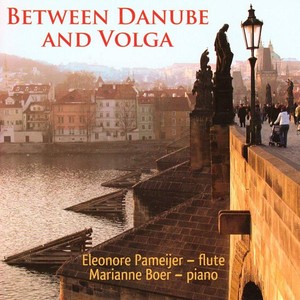
- 歌曲
- 时长
-
作曲家:George Enescu( 乔治·埃内斯库)
-
作曲家:Sergei Prokofiev( 谢尔盖·普罗科菲耶夫)
-
作品集:Sonata in D, Op. 94
-
作曲家:Erwin Schulhoff( 埃尔文·舒尔霍夫)
-
作品集:Sonata
-
作曲家:Erwin Schulhoff( 埃尔文·舒尔霍夫)
-
作品集:Sonata IV
-
作曲家:Bohuslav Martinu
-
作品集:First Sonata
-
作曲家:Alexandre Tansman
-
作品集:Sonatina
-
作品集:Sonatina V
简介
This CD presents five compositions for flute and piano by Eastern European composers originating from the Czech Republic, Poland, Romania and Russia. All were born at the end of the nineteenth century and wrote their works in the first half of the twentieth century. They witnessed great changes both in society as well as on a musical level. During their lives, concert music changed from classical-romantic to modern and experimental. Apart from their collective origin in Eastern Europe – an area bordered by the Danube and the Volga – where the Austrian-Hungarian dual monarchy reigned supreme, another important uniting factor binding these composers was the city of Paris. In the first half of the twentieth century, Paris was like a magnet for artists. The violin virtuoso, composer and conductor Georges Enescu spent most of his life there. Alexander Tansman too, left for Paris at an early age and preferred France to his native Poland. Sergei Prokofiev visited Paris in a professional capacity, remaining there for long periods of time composing ballets commissioned by Sergei Diaghilev and the Ballets Russes, but ultimately chose – even during rough political times – Russia as his country of residence. Czech composers Erwin Schulhoff and Bohuslav Martinů also could be found in the French capital. Martinů lived there from 1923 until he was forced to flee to the United States in 1941 because of the Nazi regime. Due to political circumstances, he would never return to his home country. Piano virtuoso Erwin Schulhoff enjoyed many triumphs in Paris, performing as a soloist in the major concert halls. He often collaborated with well-known French flutist René Le Roy, to whom he dedicated his Flute Sonata. In Eastern European culture, the flute was known as an instrument used in folk music, mainly as a shepherd’s flute. The clarinet and violin, however, were more popular by far, which is also reflected in most of the classical compositions. In Paris, the five composers presented on this CD were introduced to the French flute school, which blossomed under the tutelage of such flutists as Paul Taffanel, Philippe Gaubert, Louis Fleury and Marcel Moyse. Their sound was sheer, their vibrato was light. This was the moment that the flute developed into a virtuoso and full-fledged instrument, coinciding with a new compositional style in France. Impressionism took over where Romanticism left off. Succeeding Impressionism was the more direct and concise movement of neoclassicism – represented by the ‘Groupe des Six’ – which did not shy away from incorporating elements of jazz and ‘café chantant’. Clearly influenced by these exciting circumstances, composers from abroad also gladly added their contribution to the flute repertoire, shedding any predispositions they might have had. They enriched the repertoire with many great flute sonatas, combining their own musical background with the influences of the new French music. What binds them in their music is a distinctive and characteristic Eastern European sound: wistfulness, desire and passion blend with the lightness, nerve and virtuosity of the French style and the new modern age.

